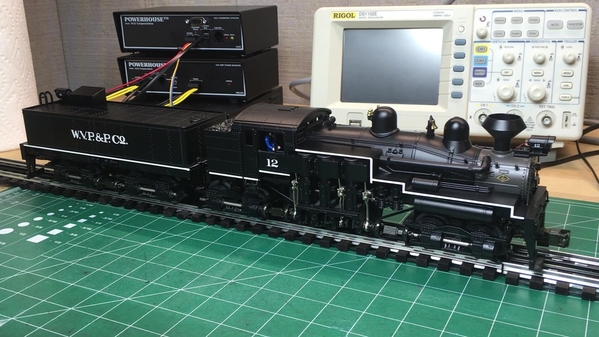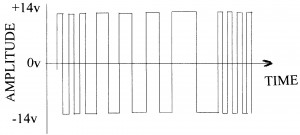I recently came into possession of a really nice early model MTH Shay. I run DCC, so I was buying it with the intent to upgrade it using a Loksound L decoder. This install turned out to be a lot of fun, so I thought it might be worth sharing.
For starters, the Shay was a perfect loco for my purposes - pristine cosmetically and virtually unused, so it was in great shape mechanically. And yet, inexpensive due to the obsolete electronics.
I dug in right away and started planning the install. Here are the tender, chassis, and boiler in their original configurations:
Here is the chassis:
And here is the boiler, with the smoke unit and lighting board:
The first thing I do is disassemble everything completely, so I have a good idea of what I'm working with as far as space, what needs to be wired where (particularly between engine and tender), where I want to connectorize things, and so on. I like to basically start with a blank slate, so everything comes out. Lights, PCBs, smoke unit, harnesses, brackets - nothing is spared! I save all the original boards and wiring, as it is frequently convenient to reuse some of the wiring and connectors for things like lights and so on.
Here is the bare boiler:
And here is the chassis. I removed all the harnessing from the tether connector board and cleaned that up, and removed from the PCB but kept the motor leads.
For this guy, I noticed two things pretty early on that influenced where I wanted to put the decoder. First, there are only five conductors in the tether. So if the decoder were to go in the tender like the original electronics, that would be impractical with all the stuff needed in the boiler. The other thing I noticed was that the decoder was a perfect drop in replacement for the lighting/smoke board! As in, almost exactly the same size and even hole locations. So I knew the decoder would go in the boiler.
Here is a test fit of the decoder in the boiler:
Here is a pic of it in place alongside the smoke unit:
With the decoder in the boiler, the only things needed in the tender are the rear light and the speaker. I prepared the tether connector board with leads for these. I connectorized these and the motor leads using standard header pin connectors to make it easy to remove the boiler.
Then I went to work on the LED lighting. I use Brickstuff warm white LEDs for a lot of stuff. They are a bit pricey, but they are extremely convenient, as they are mounted on a small pcb along with a resistor, so you can just feed them 5V. Since the Loksound L has a 5V supply on it, this makes for a nice tidy install.
They fit perfectly in the headlamp/taillamp housings:
And here are the cab and firebox lights. I put kapton tape over the cab light since I wanted a yellower tone for that:
Here are the leads for the headlight, cab light, and firebox ready to be connected to the decoder:
At this point the decoder adapter board is ready to get stuff wired up to it. In this pic, the small red leads from the LEDs are soldered to the 5V supply, while each of their black leads is soldered to a function output on the decoder. The larger gray wires are the speaker wires, the red and black wires are the track pickups, the white and yellow are the motor leads, and the blue and green are for the rear light.
Then I checked the wiring on the trucks, and reinstalled them on the chassis. The power and ground from the trucks run to a small PCB that I designed that has a couple screw terminals and a 16V TVS on it. I install these in all my locomotives, as it makes the wiring tidy and provides a bit of additional protection for the decoder. After tidying that stuff up, the chassis is ready for the boiler.
At this point, still without the decoder installed, I hook up everything electrically between the boiler, chassis, and tender, and do continuity and isolation checks on the adapter board. This is a really good step to perform to ensure everything is wired properly and to avoid smoking a new decoder. Things to check include:
- Isolation of ALL other connections from each of the two track pickups. This is vital, especially on older engines where the chassis was also the electrical return to the track for the original electronics.
- Continuity of the red lead to the track pickups.
- Continuity of the black lead to chassis ground.
- Speaker continuity (5-10 ohms depending on the speaker)
- Motor continuity (anywhere from 25 to about 200 ohms)
- Lighting continuity. If using incandescent, look for a few ohms. If using LED, you can test using diode mode.
If that all checks out, install the decoder on the adapter board and physically install it in the locomotive. Here is the decoder installed in the boiler:
Finally, just connect the pin header connectors and the boiler drops right onto the chassis!
Only one item left, and that's the tender. Pretty easy, since all of the electronics are in the boiler. Two of the leads from the tether go to the rear light, installed in the housing in the same manner as the headlight. The other two go to a substantially upgraded speaker:
But then, what to do with all that empty space? Well, the trucks on the Shay tender are driven, so how about a couple of steel ingots for ballast, just for grins:
And that's it!
I've gotten some run time on it over the last couple weeks now, and it's sweet. I'll post a video when I get a chance, but it's a very smooth runner and just plain fun to operate and watch. The sounds with the Loksound and that big speaker are awesome, and you almost need time-lapse photography to see it creep along on speed step 1. ![]()











